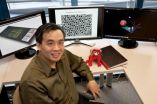(Press-News.org) VIDEO:
University of Iowa researchers have determined that thigh size in obese people is a reason their hip implants are more likely to fail.
Click here for more information.
University of Iowa researchers have determined that thigh size in obese people is a reason their hip implants are more likely to fail.
In a study, the team simulated hip dislocations as they occur in humans and determined that increased thigh girth creates hip instability in morbidly obese patients (those with a body mass index (BMI) greater than 40). The researchers propose that surgeons modify surgical procedures to minimize the chance of dislocation in obese patients and consider other designs for hip replacement implants.
"We have shown that morbidly obese patients' thighs are so large that they are actually pushing each other outward and forcing the implant out of its socket," says Jacob Elkins, a UI graduate student and first author of the paper published in the journal Clinical Orthopaedics and Related Research. "Studies have shown up to a 6.9-fold higher dislocation rate for morbidly obese patients compared to normal weight patients.
Total hip replacement gives mobility back to people who experience debilitating hip joint pain. According to the National Institute of Arthritis and Musculoskeletal and Skin Disease (NIAMS), 231,000 total hip replacements are performed annually in the U.S. and more than 90 percent of these do not require follow-up repair or replacement. But when an implant fails, it is painful, and costly. Studies have shown that dislocation ranks as the most common reason for failed implants, according to Medicare hospital discharge data.
A hip implant is a ball-in-socket mechanism, designed to simulate a human hip joint. However, it lacks the connective tissue that stabilizes a normal hip joint, meaning the ball portion of the implant can sometimes "pop out."
Clinical studies point to an increased dislocation risk among obese patients with total hip replacements, but the reasons have remained unclear. Dislocation requires extreme range of motion, such as flexing at the waist. Given the reduced range of motion in the obese, why do they experience more dislocations?
Using a computational model he created to understand how a hip implant works in patients, Elkins and research collaborators analyzed 146 healthy adults and six cadaver pelvises. They examined the effects of thigh-on-thigh pressure on the hip implant during a wide range of movements from sitting to standing. With the ability to simulate movements in human bodies of varying sizes, the team could test different implants. They also looked at the various implants' performances in different body types. They used a hip-center-to-hip-center distance of 200 millimeters as a basis for their analyses of thigh girth for eight different BMIs, ranging from 20 to 55.
The research team ran computations to examine the joint stability of several different hip implants. They tested two femoral head sizes (28 and 36 millimeters), normal versus high-offset femoral neck, and multiple cup abduction angles.
The researchers report three main findings: 1) thigh soft tissue impingement increased the risk of dislocation for BMIs of 40 or greater; 2) implants with a larger femoral head diameter did not substantially improve joint stability; 3) using an implant with a high-offset femoral stem decreased the dislocation risk.
"The larger your legs are, the more force that goes through the hip joint," Elkins says. "It's a simple concept. When your thighs are real big, they push on the hips."
Surgeons treating obese hip implant patients can use the study findings to select better implant designs and modify their surgical procedures to minimize the chance of dislocation in obese patients, the researchers say.
"The number one thing surgeons can do is what is called a 'high offset femoral stem,'" says senior author Thomas Brown, UI professor of orthopaedic surgery, referring to the portion of the implant that attaches to the patient's upper thigh bone, or femur. "Basically, the implant's femoral stem is longer, so it effectively shifts the leg further away from the center rotation of the joint. The thighs then would need to move even further inward before they would abut one another and generate the forces necessary for dislocation."
INFORMATION:
The study, titled "Morbid obesity may increase dislocation in total hip patients: A biomechanical analysis," was published online last month. Elkins is in the UI's College of Engineering Biomechanical Engineering Program and the Carver College of Medicine's Medical Scientist Training Program.
Other authors are Matej Daniel, assistant professor at Czech Technical University in Prague, Czech Republic, and former Fulbright Research Scholar at UI Hospitals and Clinics; Douglas Pedersen, UI research associate professor of orthopaedic surgery; Bhupinder Singh, UI doctoral candidate in physical therapy; John Yack, UI associate professor of physical therapy; and John Callaghan, UI professor of orthopaedic surgery.
The National Institutes of Health, the Veterans Administration, and the National Center for Resource Resources funded the research.
END
A once-promising discovery linking prostate cancer to an obscure retrovirus derived from mice was the result of an inadvertent laboratory contamination, a forensic analysis of tissue samples and lab experiments – some dating back nearly a decade – has confirmed.
The connection, which scientists have questioned repeatedly over the last couple years, was first proposed more than six years ago, when the telltale signature of the virus, known as XMRV, was detected in genetic material derived from tissue samples taken from men with prostate cancer.
Later studies failed ...
MADISON — Pacifiers may stunt the emotional development of baby boys by robbing them of the opportunity to try on facial expressions during infancy.
Three experiments by a team of researchers led by psychologists from the University of Wisconsin–Madison tie heavy pacifier use as a young child to poor results on various measures of emotional maturity.
The study, published today by the journal Basic and Applied Social Psychology, is the first to associate pacifiers with psychological consequences. The World Health Organization and American Academy of Pediatrics already ...
Writer: Emil Venere, 765-494-4709, venere@purdue.edu
Source: Bedrich Benes, 765-496-2954, bbenes@purdue.edu
Related websites:
Bedrich Benes: http://www.tech.purdue.edu/CGT/Faculty-And-Staff/index.cfm?dept=Computer%20Graphics%20Technology&id=120
IMAGE CAPTION:
Bedrich Benes, an associate professor of computer graphics at Purdue University, is working with Advanced Technology Labs of Adobe Inc. to develop a computer program that automatically strengthens objects created using 3-D printing. The innovation is needed because the printed fabrications are often fragile ...
Inflammation is the hallmark of many human diseases, from infection to neurodegeneration. The chemical balance within a tissue is disturbed, resulting in the accumulation of reactive oxygen species (ROS) such as hydrogen peroxide, which can cause oxidative stress and associated toxic effects.
Although some ROS are important in cell signaling and the body's defense mechanisms, these chemicals also contribute to and are indicators of many diseases, including cardiovascular dysfunction. A non-invasive way of detecting measurable, low levels of hydrogen peroxide and ...
MADISON -- Among his many qualities, the pioneering wildlife ecologist Aldo Leopold was a meticulous taker of field notes.
Rising before daylight and perched on a bench at his Sauk County shack in Depression-era Wisconsin, Leopold routinely took notes on the dawn chorus of birds. Beginning with the first pre-dawn calls of the indigo bunting or robin, Leopold would jot down in tidy script the bird songs he heard, when he heard them, and details such as the light level when they first sang. He also mapped the territories of the birds near his shack, so he knew where the ...
HOUSTON – (Sept. 18, 2012) – Contrary to the prevailing theories that music and language are cognitively separate or that music is a byproduct of language, theorists at Rice University's Shepherd School of Music and the University of Maryland, College Park (UMCP) advocate that music underlies the ability to acquire language.
"Spoken language is a special type of music," said Anthony Brandt, co-author of a theory paper published online this month in the journal Frontiers in Cognitive Auditory Neuroscience. "Language is typically viewed as fundamental to human intelligence, ...
Although depression and prejudice traditionally fall into different areas of study and treatment, a new article suggests that many cases of depression may be caused by prejudice from the self or from another person. In an article published in the September 2012 issue of Perspectives on Psychological Science, a journal of the Association for Psychological Science, William Cox of the University of Wisconsin-Madison and colleagues argue that prejudice and depression are fundamentally connected.
Consider the following sentence: "I really hate _____. I hate the way _____ look. ...
While wave watching is a favorite pastime of beachgoers, few notice what is happening in the shallowest water. A closer look by two University of Colorado Boulder applied mathematicians has led to the discovery of interacting X- and Y-shaped ocean waves that may help explain why some tsunamis are able to wreak so much havoc.
Professor Mark Ablowitz and doctoral student Douglas Baldwin repeatedly observed such wave interactions in ankle-deep water at both Nuevo Vallarta, Mexico, and Venice Beach, Calif., in the Pacific Ocean -- interactions that were thought to be very ...
ANN ARBOR, Mich. — A small subset of patients with open-angle glaucoma (OAG) account for a large proportion of all glaucoma-related charges in the United States, according to new data published by researchers at the University of Michigan Kellogg Eye Center and Washington University, St. Louis.
These findings have importance for future evaluations of the cost-effectiveness of screening and treatment for glaucoma.
"We've identified risk factors associated with patients who are the costliest recipients of glaucoma-related eye care," says Joshua D. Stein, M.D., M.S., ...
Powerful thunderstorms wrapped tightly around Hurricane Lane's center as it continued moving through the eastern Pacific Ocean. When NASA's Terra satellite passed over Lane it captured a close-up view of the storm and noticed that Lane's eye had become cloud-filled as if being punched in the eye. Nature is expected to fight Lane more and win over the next couple of days.
The Moderate Resolution Imaging Spectroradiometer (MODIS) instrument captured a close-up of Lane on Sept. 17 at 3:25 p.m. EDT when it was still a hurricane. In the image, Lane's eye appeared obscured ...




